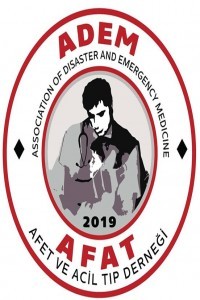2020 REHBERLERİNE GÖRE TOKSİKOLOJİ VE YAŞAM DESTEĞİ
2020;, toksikoloji;, CPR;, yaşam desteği
TOXICOLOGY AND LIFE SUPPORT ACCORDING TO THE 2020 GUIDELINES
2020;, toxicology;, CPR;, life support,
___
- 1. Highlights of the 2020 American Heart Association (AHA) Guidelines for CPR and ECC.https://cpr.heart.org/-/media/cpr-files/cpr-guidelines-files/highlights/hghlghts_2020_ecc_guidelines_english.pdf. Erişim: 01.11.2020.
- 2. Merchant RM, et al. Part 1: Executive Summary: 2020 American Heart Association Guidelines for Cardiopulmonary Resuscitation and Emergency Cardiovascular Care. Circulation. 2020 Oct 20;142(16_suppl_2):S337-S357.
- 3. Panchal AR, et al. Part 3: Adult Basic and Advanced Life Support: 2020 American Heart Association Guidelines for Cardiopulmonary Resuscitation and Emergency Cardiovascular Care. Circulation. 2020 Oct 20;142(16_suppl_2):S366-S468.
- 4. Topjian AA, et al. Part 4: Pediatric Basic and Advanced Life Support: 2020 American Heart Association Guidelines for Cardiopulmonary Resuscitation and Emergency Cardiovascular Care. Circulation. 2020 Oct 20;142(16_suppl_2):S469-S523.
- 5. Aziz K, et al. Part 5: Neonatal Resuscitation: 2020 American Heart Association Guidelines for Cardiopulmonary Resuscitation and Emergency Cardiovascular Care. Circulation. 2020 Oct 20;142(16_suppl_2):S524-S550.
- 6. Chandler RK, Villani J, Clarke T, McCance-Katz EF, Volkow ND. Addressing opioid overdose deaths: The vision for the HEALing communities study. Drug Alcohol Depend. 2020 Dec 1; 217: 108329.
- 7. Scholl L, et al. Drug and opioid-involved overdose deaths—United States, 2013-2017. MMWR Morb Mortal Wkly Rep. 2018;67:1419–1427.
- 8. Clarke SF, et al. Naloxone in opioid poisoning: walking the tightrope. Emerg Med J. 2005;22:612–616.
- 9. Zuckerman M, et al. Pitfalls of intranasal naloxone. Prehosp Emerg Care. 2014;18:550–554.
- 10. Penninga EI, et al. Adverse Events Associated with Flumazenil Treatment for the Management of Suspected Benzodiazepine Intoxication–A Systematic Review with Meta-Analyses of Randomised Trials. Basic Clin Pharmacol Toxicol. 2016;118:37–44.
- 11. Neal JM, et al. The Third American Society of Regional Anesthesia and Pain Medicine Practice advisory on local anesthetic systemic toxicity: executive summary 2017. Reg Anesth Pain Med. 2018;43:113–123.
- 12. Harrigan RA, et al. ECG abnormalities in tricyclic antidepressant ingestion. Am J Emerg Med. 1999;17:387–393.
- 13. Bebarta VS, et al. Incidence of Brugada electrocardiographic pattern and outcomes of these patients after intentional tricyclic antidepressant ingestion. Am J Cardiol. 2007;100:656–660.
- 14. Parker-Cote JL, et al. Challenges in the diagnosis of acute cyanide poisoning. Clin Toxicol (Phila). 2018;56:609–617.
- 15. Baud FJ, et al. Elevated blood cyanide concentrations in victims of smoke inhalation. N Engl J Med. 1991;325:1761–1766.
- 16. Baud FJ, et al. Relation between plasma lactate and blood cyanide concentrations in acute cyanide poisoning. BMJ. 1996;312:26–27.
- ISSN: 2717-7424
- Başlangıç: 2020
- Yayıncı: Afet ve Acil Tıp Derneği
2020 REHBERLERİNE GÖRE ÇOCUK VE BEBEKTE KARDİYOVASKÜLER YAŞAM DESTEĞİ
2020 REHBERLERİNE GÖRE GEBEDE KARDİYOVASKÜLER YAŞAM DESTEĞİ
2020 REHBERLERİNE GÖRE YETİŞKİNLERDE KARDİYOVASKÜLER YAŞAM DESTEĞİ
COVİD-19 PANDEMİ SÜRECİNİN YAŞLILAR ÜZERİNDEKİ BİYO-PSİKO-SOSYAL ETKİLERİ ÜZERİNE BİR DEĞERLENDİRME
2020 REHBERLERİNE GÖRE TOKSİKOLOJİ VE YAŞAM DESTEĞİ
2020 REHBERLERİNE GÖRE YENİDOĞANDA KARDİYOVASKÜLER YAŞAM DESTEĞİ
HASTANEDE SOSYAL HİZMET UZMANI VE TIBBİ SOSYAL HİZMET FARKINDALIĞININ DEĞERLENDİRİLMESİ
Büşra YAVUZ ERDAL, Ecem ÇAKIN, Berna ÇALGI, Serkan DOGAN, Doğaç Niyazi ÖZÜÇELİK
